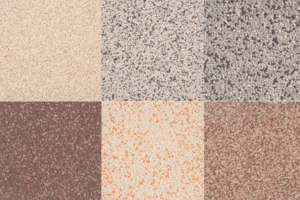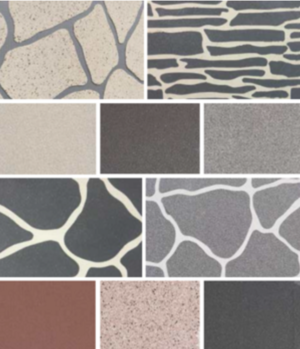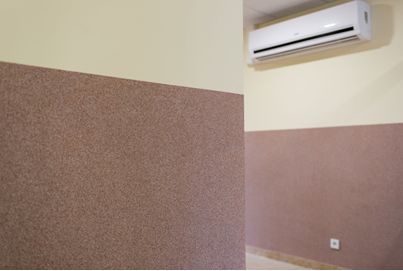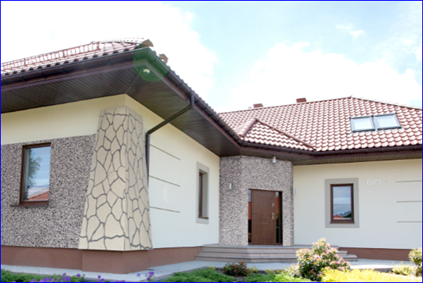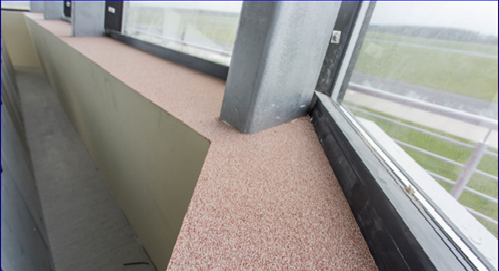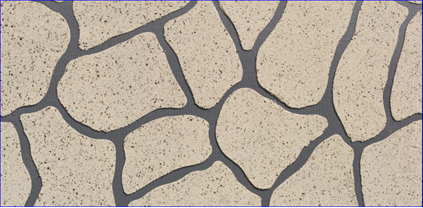- Products
- Systems
- Tools & Services
News
Clever solution for a façade – mosaic render
Mosaic render is made of aggregate bonded with specially developed base which main ingredient is acrylic resin. It is used both for interior decoration and upon building façades. It offers vast flexibility when it comes to designing and finishing the compartments – it is often applied on plinth section of a building or upon wall fragments. ATLAS offers mosaic renders DEKO M/AVAL KT 77 in three options differing in the form of preparation and components.
Advantages of DEKO M render
- Resistant to mechanical damage and weather conditions – the coat is resistant to frost and water (does not soak and protects façade against harmful effects of water action).
- High hardness (owing to the presence of quartz aggregate) – it is resistant to dirt, washing and abrasion – its surface can be washed with water and cleaned without risk of render detaching.
- Resistant to UV radiation – preserves the colour for a very long time and does not fade.
- DEKO M TM1 variant has the lowest consumption on the market (approx. 2 kg/m2).
- MYCO PROTECT system – based on biocides, guarantees long time effective protection against biological corrosion, i.e. growth of fungi and algae on the surface of the render.
- Easy application – ready to use immediately after selected components mixing.
- Wide range of colours – one can get 84 colors in TM1 variant. The aggregate combinations can be enriched with mica or brocade (it gives 168 more colours for TM1), 60 standard colours and 20 colours of ready mix TM3 variant.
- Manual and mechanical application possible.
What do we offer?
ATLAS DEKO M/AVAL KT 77 gives the opportunity to purchase the decorative render in several variants:
1. DEKO M TM3 ready mix includes:
- DEKO M mosaic render base,
- ready compositions of aggregates – 20 ready-made colours to choose from, already mixed
in the bag.
2. DEKO M TM1 includes:
- DEKO M mosaic render base,
- 7 aggregate colours which can be mixed in any combination – always use 3 colours (same or different) – you can get 84 different colours.
In order to enrich the colours even more, one can add:
- glitter (silver colour),
- mica – fine, shiny mineral chips (black colour).
The combination of colors, glitter and mica gives up to 252 color variations.
In addition, DEKO M TM1 render may be applied with the use of templates. We especially recommend the templates which imitate irregular shapes, for example stone. The render formed with a template is less expensive in comparison to natural stone, but it still looks equally impressive.
Mosaic render: what one should know
- Appropriatesubstrate – mosaic render cannot be applied upon weak or uneven substrate. The substrate for the render should be perfectly prepared – the finer the aggregate, the better the substrate should be.
If one applies mosaic render upon uneven surface, it may result in exposure of every uneveness and finally leads to higher material consumption and costs.
- The application technique can be challenging for inexperienced contractor. Mass should always be applied in the same direction – it is very important, because if the render is applied in different directions, it is clearly visible on the façade and very difficult to fix afterwards.
The render should also be applied with the “wet on wet” technique. This means that fragments of walls with already applied render should be joined together with subsequent coats
before the mass starts to bind. Attempts to adjoin hardened render with fresh render are pointless and lead to appearance of unaesthetic protrusion and joints traces.
- Weather conditions – mosaic render must be applied when temperature is optimal (5o-25oC).
It should not be applied when the façade is exposed to direct sunlight – the render hardens very quickly, because the resin included in render composition binds much faster in warm conditions. In result, it becomes very difficult to apply the render tupon façade.
Attention! Mosaic render can be applied in temperature from 0°C – after adding Atlas Eskimo agent.
|
Mosaic render – advantages and disadvantages |
||
|
FOR INVESTOR |
BEAUTIFUL EFFECT Owing to rich colourful palette and possibility to form stone or brick texture on the façade with the use of templates. |
|
|
FAÇADE DURABILITY FOR YEARS Owing to the hydrophobic surface. Resistance to dirt, washing, abrasion, UV radiation and water action. |
|
|
|
PRICE Owing to low consumption. approx. 20 kg (TM1 render)/10m2 approx. 40 kg (TM3 render)/10m2 |
PRICE It is more expensive solution than top finish made of traditional acrylic render. |
|
|
|
ADVANTAGES |
DISADVANTAGES |
|
FOR CONTRACTOR |
BETTER PROFIT Contractor can earn more money per 1m2 of render. |
|
|
APPLICATION Owing to no texture forming. |
SUBSTRATE PREPARATION Particular diligence in preparation of the substrate – the finer the aggregate, the better the substrate should be. |
|
Original text: Łukasz Kulczycki, ATLAS Group
English text: Piotr Marciniak, Michał Gosławski, ATLAS Group
